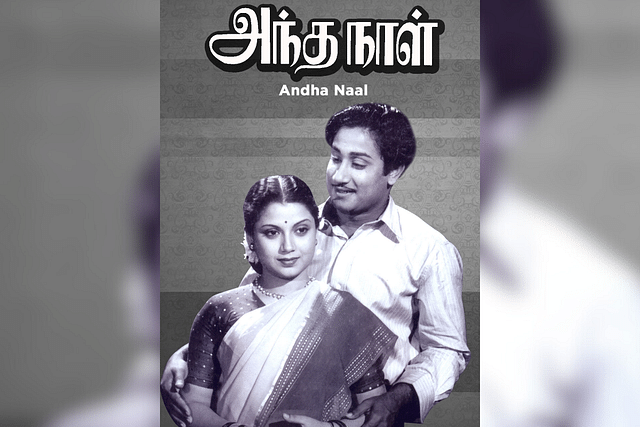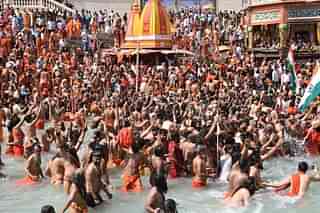Movies
The First Ever Film Noir In Tamil Was Released 70 Years Ago; It Remains Fascinating Even Today
K Balakumar
Apr 07, 2024, 06:00 AM | Updated 12:36 PM IST
Save & read from anywhere!
Bookmark stories for easy access on any device or the Swarajya app.

In the very first scene of the film, the hero is shot dead.
Tamil cinema has never seen a more arresting introduction before or after. Not just its beginning, but all through its run time, Andha Naal (That Day) was one of its kind. And since its release in April 1954, the legend of that film has only grown.
Andha Naal had many firsts to its credit. It was definitely the first ever film noir in Tamil. In an era when songs in movies were dime-a-dozen, it was the first one to release without a single song. Its camera work and the chiaroscuro lighting technique are now course material in cinematography classes.
With its story based on British director Anthony Asquith’s Woman In Question and the narrative on Akira Kurosawa’s legendary Rashomon, the film is a lesson in how to take inspiration rather than merely copy from foreign sources. And its run time, decidedly lesser than the standard offerings of the time, was another of its novelty.
All this was pulled off by one man to whom the frequently misused tag 'genius' actually fits snugly.
S Balachander, better known as Veenai Balachander, was a man of myriad parts. He was a musician who could play nine different instruments — all at an expert level and, more importantly, self-taught.
He was a writer, an actor, a director, a film music director, and he belonged to a family of talented artists who were pioneers in Tamil cinema and music.
The story of how Balachander and his skilful siblings all debuted in the same film, doyen V Shantaram's Tamil film Seetha Kalyanam (1934), is among the fascinating stories of Indian cinema.
According to historian and chronicler of Tamil films Randor Guy, Seetha Kalyanam was Shantaram's effort to offset the losses he made with the Hindi film Sairandhri (1933), India’s first film in colour.
Shantaram decided to use the sets and other property that he had erected for Sairandhri at his famed Prabhat Studios in Kolhapur for Seetha Kalyanam, too.
Shantaram Impressed
Shantaram reportedly wrote to the Madras-based film magazine Sound and Shadow seeking help to source musicians and artists for his film. One thing led to another and Madras-based lawyer Sundaram Iyer decided to take up the chance to be a part of Seetha Kalyanam.
Iyer's two daughters, S Jayalakshmi and S Saraswathi, his two sons, S Rajam and S Balachander (who was barely six years old then), accompanied him. Their music tutor, Papanasam Sivan, was also part of the entourage. And what happened in Kolhapur left a great impact on Tamil cinema.
Rajam and his sister Jayalakshmi were chosen to play the lead Rama, and Sita, respectively, in the film. (Siblings playing husband and wife on-screen did create controversy in those conservative times. Heck, it would do so even now).
Another sister, Saraswathi, played the role of Urmila (Lakshmana's wife). Their father, Sundaram, handled the role of Janaka. And the young Balchander, who showed his flair for instruments even then, was allowed to handle the percussion instrument Kanjira.
Shantaram and the film's director, his cousin Baburao Pendharkar, were so impressed with the precocious Balachander that they had a special scene in which he was asked to perform in Ravana's court. Shantaram was so enamoured of the boy that he also presented him with a tabla set.
This first-ever colour film in Tamil achieved decent success and the careers of Rajam and Jayalakshmi as singing stars was launched.
But we will focus on Balachander, who became a bigger legend in South Indian music and films.
Eclectic Personality
After his return from Kolhapur, the multi-faceted Balachander dabbled in many things. Much before he made it to his teens, he became a music artist with All India Radio and this exposed him to more music instruments there. And his lifelong love for veena started there.
He got to tour various places as a musician, was simultaneously excelling in chess, and was said to contribute puzzles to local newspapers. In one word, he was eclectic.
Furthermore, the film bug also bit him. He acted in the film Rishyasringar (1941). And by the time he was 21, Balachander decided to make his own film.
With his sensibilities honed by Western films and books, Balachander, not surprisingly, chose to reprise Danny Kaye's Wonder Man (1945) in Tamil as Idhu Nijama (1948). Though the film's direction is credited to Krishna Gopal, it was Balachander who directed most of the scenes.
He wrote the film's story and script, acted in the lead roles (double action), helmed the music, and sang in it. The film was well noted and later became the inspiration for Kamal Haasan's highly successful Kalyanaraman (1979).
He followed it with En Kanavar (1948) and crime-thriller Kaidhi (1951). He also acted in family dramas like Devaki (1951), Rajambal (1951), Rani (1952), Inspector (1953), and Penn (1954). And by 1954, he was ready for a breakthrough.
As it happened, the fine working partnership that he had struck with the dialogue writer of Idhu Nijama had an important bearing on Andha Naal. 'Javar' Seetharaman (actually 'Javert', based on his role in Ezhai Padum Padu (1950), the Tamil remake of Victor Hugo's Les Miserables) had become a bankable writer and actor by 1954.
And Balachander, who wanted to make a Rashomon-like exploration of human perception in Tamil, decided that Javar was the right man to work with. So, for Andha Naal, Javar came in as both a screenplay writer and the main actor.
No Film Like Andha Naal
Andha Naal, it is said, was first offered to All India Radio, but somehow the authorities there did not feel that it would work. But the hoary AVM Studios, which came to know about the story, felt that it would work.
The story, set in the backdrop of the Second World War and the Japanese attack on Madras in October 1943, was about a young radio engineer. He is the one killed in the first scene. It was played by none other than the great Sivaji Ganesan.
Why was he killed? An investigator (played by Javar) steps in, and he begins to question the rest of the people in the family and neighbours. The story then unfolds as each one giving their view of the dead person. Each different flashback throws up different perceptions of the man.
The taut screenplay (no songs and fights add to the film's quick flow) keeps the suspense alive till the last scene when the killer is revealed.
That Ganesan chose to do a film in which he was an anti-hero and even a traitor of sorts shows his courage in choosing different roles early in his career. It also signals his conviction in Balachander's ability.
The film did not do all that well at the box office, but its legend has only grown since then.
Andha Naal was taken note of, especially its stylised approach. In storytelling, it throws up MacGuffins and red herrings — it is now commonplace in murder mysteries, but then it was all novel and fresh.
The cinematography, handled by the talented S Maruti Rao, was another 'wow factor' in the film. It showed that suspense could be created even when using a static camera, through the interplay of light and atmospherics. The close-ups and sharp-cutting (editor S Surya) were also unique for those times.
Even though he subsequently acted in films like Savithri (1955) and Maragadham (1959), Balachander was keen on thrillers and enigmatic suspense movies — he was a big fan of Alfred Hitchcock.
He got his own production house, S B Creations, and came out with three films in which he acted and directed — Avana Ivan (1962), Bommai (1964), and Nadu Iravil (1965).
In each film, he tried to leave his stamp of newness. For instance, check this end credits roll in Bommai. It is unlike anything seen until then, as all the cast and crew members personally show up and introduce themselves.
But after 1965, Balachander, with his typical maverick spirit, decided to turn his back on cinema. He quit films and chose to focus on Carnatic music, which he did till his death on a concert tour to Bhopal in 1990.
His style of music was not for the amateurs. It was nuanced and tinged with classicism. He typically did not choose the beaten path for his music. Look at this video where he introduces his accompanists before the concert, an unheard-of thing at the time. And also listen to the novelty-filled Hamsadhwani, a style that he made all his own.
The date of his death was 13 April — exactly the same as the release date of his most famous film, Andha Naal. As with his life, he got his timing right even in death, too. The day was his Andha Naal in more ways than one.
Save & read from anywhere!
Bookmark stories for easy access on any device or the Swarajya app.
Support Swarajya's 50 Ground Reports Project & Sponsor A Story
Every general election Swarajya does a 50 ground reports project.
Aimed only at serious readers and those who appreciate the nuances of political undercurrents, the project provides a sense of India's electoral landscape. As you know, these reports are produced after considerable investment of travel, time and effort on the ground.
This time too we've kicked off the project in style and have covered over 30 constituencies already. If you're someone who appreciates such work and have enjoyed our coverage please consider sponsoring a ground report for just Rs 2999 to Rs 19,999 - it goes a long way in helping us produce more quality reportage.
You can also back this project by becoming a subscriber for as little as Rs 999 - so do click on this links and choose a plan that suits you and back us.
Click below to contribute.





